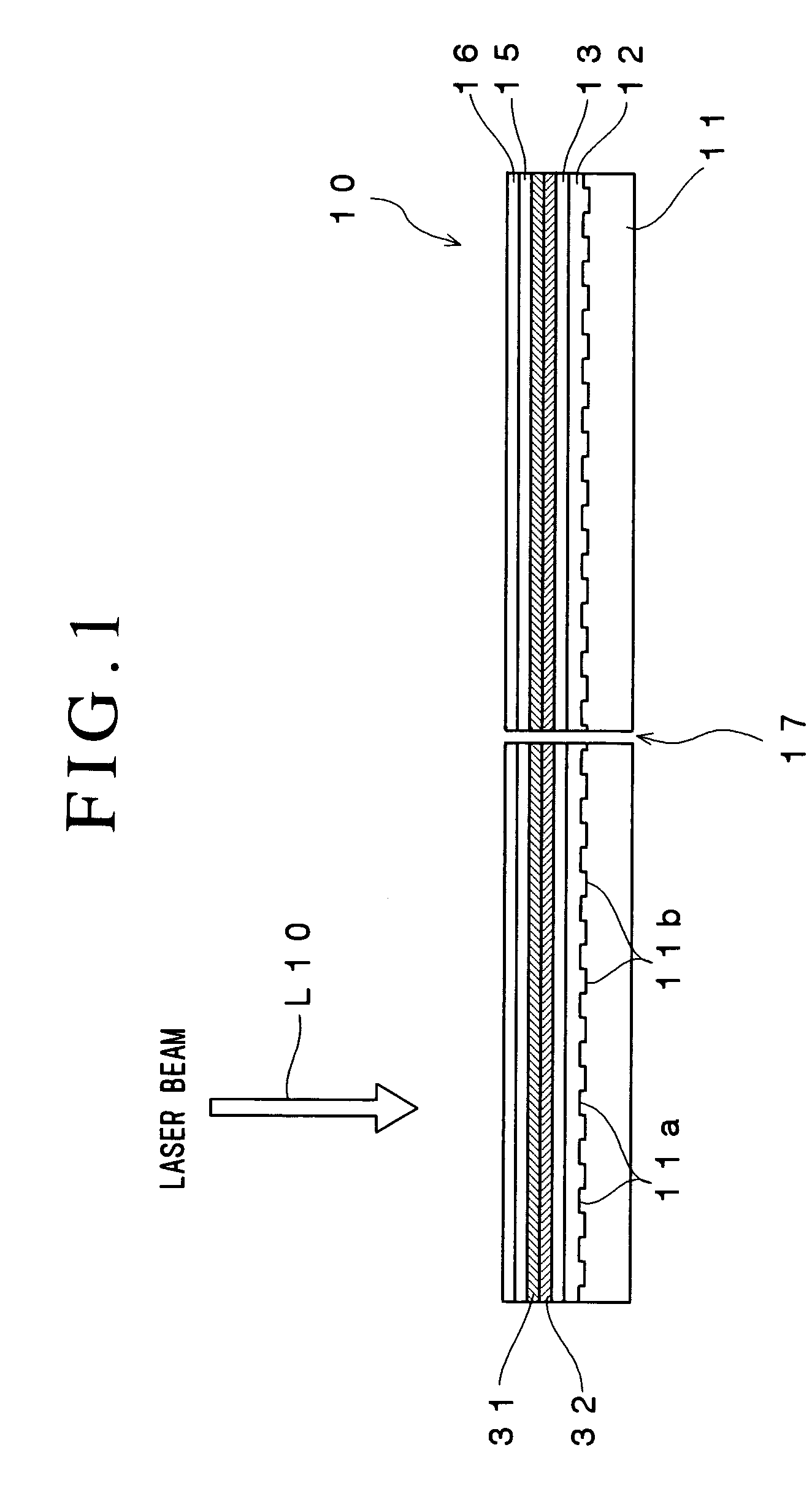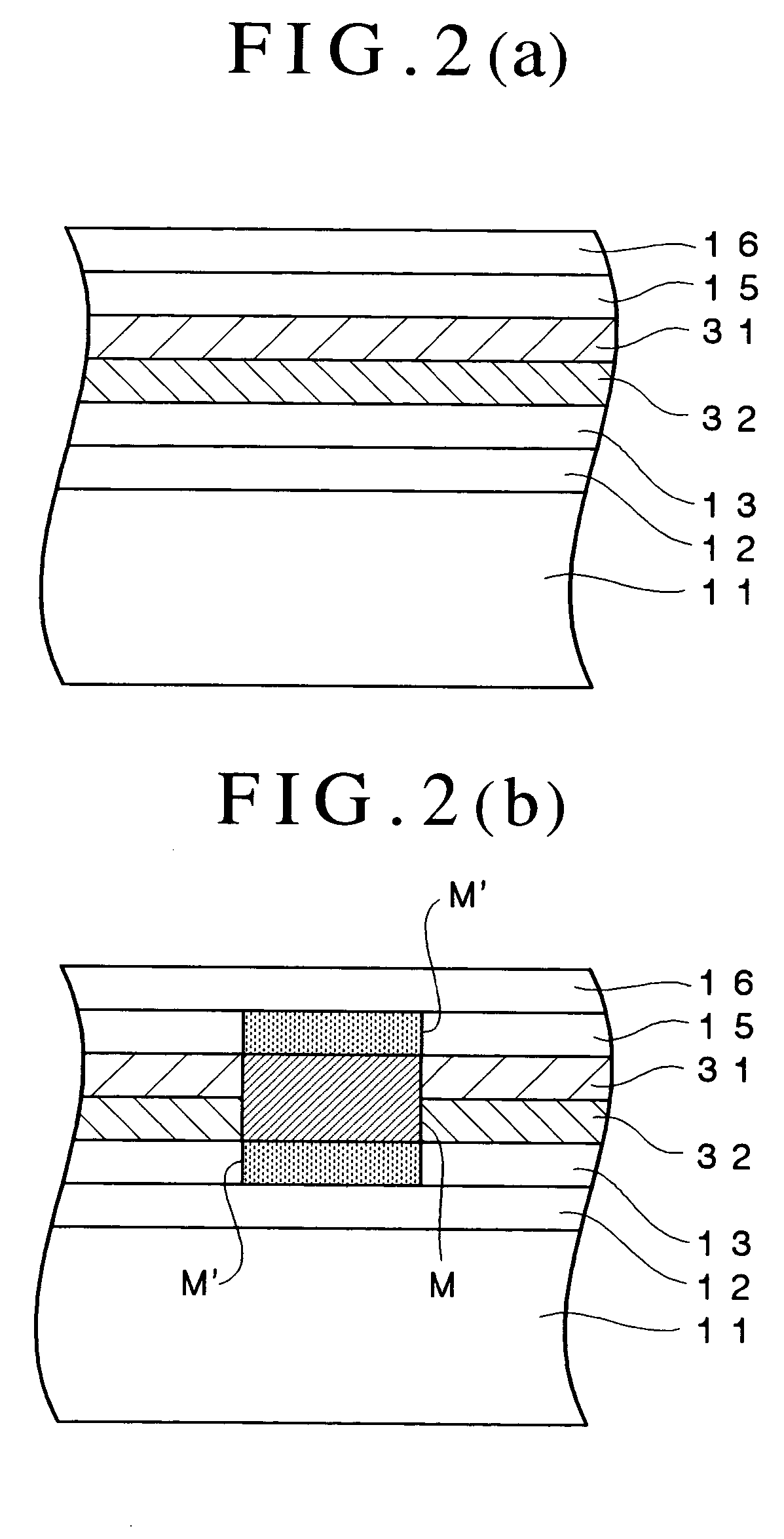Optical recording medium and method for recording data in the same
a technology of optical recording medium and data, applied in the direction of optical recording/reproducing/erasing method, recording strategy, instruments, etc., can solve the problems of difficult to improve long-time storage reliability, difficult to reproduce a signal having a good c/n ratio, and difficult to control the thickness of the first recording layer 31 and the second recording layer 32
- Summary
- Abstract
- Description
- Claims
- Application Information
AI Technical Summary
Benefits of technology
Problems solved by technology
Method used
Image
Examples
working example 1
[0134] An optical recording medium sample #1 having the same structure as that shown in FIG. 1 was fabricated in the following manner.
[0135] A polycarbonate substrate having a thickness of 1.1 mm and a diameter of 120 mm was first set on a sputtering apparatus. Then, a reflective layer containing Ag as a primary component and having a thickness of 100 nm, a second dielectric layer containing a mixture of ZnS and SiO.sub.2 and having a thickness of 28 nm, a second recording layer containing Cu as a primary component, added with 21 atomic % of Mg and having a thickness of 5 nm, a first recording layer containing Si as a primary component and having a thickness of 5 nm and a first dielectric layer containing the mixture of ZnS and SiO.sub.2 and having a thickness of 22 nm were sequentially formed on the polycarbonate substrate using the sputtering process.
[0136] The mole ratio of ZnS to SiO.sub.2 in the mixture of ZnS and SiO.sub.2 contained in the first dielectric layer and the second...
working example 2
[0154] An optical recording medium sample #3 was fabricated in the manner of the optical recording medium sample #1, except that a second recording layer containing Al as the primary component and added with 17 atomic % of Mg was formed.
[0155] Similarly to the Working Example 1, data were recorded in the optical recording medium sample #3, and the first recording layer, the second recording layer, the first dielectric layer and the second dielectric layer in the optical recording medium sample #3 were observed.
[0156] It was observed in the optical recording medium sample #3 that materials of the first recording layer and the second recording layer were mixed at a region where the record mark was formed and that materials of the first recording layer and the second recording layer were not mixed in the blank region.
[0157] Further, ZnS crystal was observed at regions of the first dielectric layer and the second dielectric layer adjacent to the record mark in the optical recording medi...
working example 3
[0159] An optical recording medium sample #4 was fabricated in the manner of the optical recording medium sample #1, except that a second recording layer containing Cu as the primary component and added with 23 atomic % of Al and 12.8 atomic % of Au was formed.
[0160] Data were recorded in the optical recording medium sample #4 using the optical recording medium evaluation apparatus used in the Working Example 1 and using a laser beam whose power was modulated in accordance with the single pulse pattern shown in FIG. 3.
[0161] The ground power Pb1 of the single pulse pattern was set to 0.1 mW and the recording power Pw1 thereof was set to 3.8 mW.
[0162] The other recording conditions were the same as those used in the Working Example 1.
[0163] Similarly, data were recorded in the optical recording medium sample #4 by modulating the power of the laser beam in accordance with the basic pulse train pattern shown in FIG. 4.
[0164] The width of each pulse of the basic pulse train pattern was ...
PUM
 Login to View More
Login to View More Abstract
Description
Claims
Application Information
 Login to View More
Login to View More - R&D
- Intellectual Property
- Life Sciences
- Materials
- Tech Scout
- Unparalleled Data Quality
- Higher Quality Content
- 60% Fewer Hallucinations
Browse by: Latest US Patents, China's latest patents, Technical Efficacy Thesaurus, Application Domain, Technology Topic, Popular Technical Reports.
© 2025 PatSnap. All rights reserved.Legal|Privacy policy|Modern Slavery Act Transparency Statement|Sitemap|About US| Contact US: help@patsnap.com



